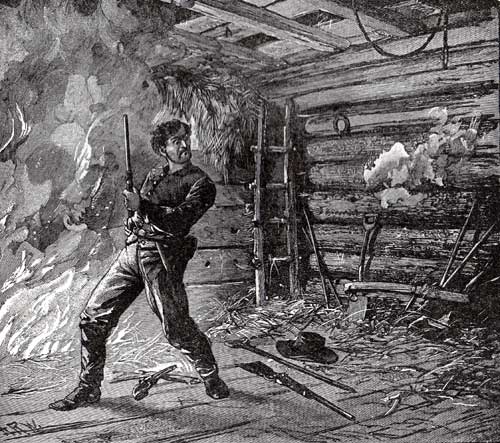After the deadly acts were committed, John Wilkes Booth spurred his horse, and rode furiously into the night. His intentions were to meet up with with David Herold and head towards the Southern sympathizers in Virginia. As Booth rode in the night, Lewis Powell panicked and could not find a way to escape from Washington. Instead of trying to make his way out, Powell stayed in the city and rode around, lost in the labyrinth that were the streets of Washington, D.C.1 Booth met up with Herold and made his way to the Surratt Tavern. The two men hopped off their horses and entered the tavern, and it was here that they gathered a carbine rifle and some ammunition, and began to plan their next move.2 Booth, still hurt from his fall onto the stage, persuaded Herold to take a slight detour to visit a doctor to fix his leg.

Booth and Herold rode their horses for about four hours from the Surratt Tavern towards the house of Dr. Samuel Mudd. The pair reached the house at around four in the morning, and woke up Dr. Mudd.2 By that time, the news of the assassination had not yet reached Dr. Mudd, so he bought the story that Booth told him, quickly splinted his leg, and offered to house the two for a couple of hours. In the afternoon, after a trip into town, Dr. Mudd discovered that there was a manhunt for Booth and upon arriving back home, demanded that the two leave, and they did.4
The duo roamed aimlessly through the woods, until they wandered onto a ranch owned by Samuel Cox, a Southern sympathizer.5 Booth revealed his identity to him, and discussed the assassination with the man, and Cox agreed to let him stay until his foster brother, Thomas Jones, arrived and would help him cross the Potomac River to reach Virginia, where Booth believed he would be welcomed as a hero.6 Once Jones arrived, Booth demand a newspaper to see what the country thought of his actions. Booth believed that he would be thought of as a national a hero, but instead, the country was infuriated. The newspapers called him a coward and a common cut throat.7 All hopes of being the country’s savior was destroyed, and Booth began to write his final words in his diary.
After Jones led the men across the Potomac, Booth and Herold continued south finding different places to hide from the authorities, until finally they reached the farm of one Richard Garrett in Bowling Green, Virginia.8 It was here the two believed that they would be safe. The Garrett family offered a place in their barn for the two to sleep, and the duo accepted it graciously.9
While Booth and Herold were settling in, Lieutenant Edward Baker was hot on the trail of the assassins and found information that led him and his fifty troops to the Garrett Farm. Within a couple of hours, Lt. Baker arrived at the Garrett Farm and commanded his troops to surround the barn.10 Baker attempted to have Booth surrender, but Booth would not budge. After an hour of dialogue, Herold ran out of the barn with hopes of surrendering. As soon as he was out of the barn, he was arrested and tied to a tree. As more time passed, Baker became impatient. With no intention to kill Booth, Baker set the barn on fire in an attempt to flush him out.11
Booth seeing how fast the fire was spreading ran with his crutches and his carbine in hand to try and put out the fire. While attempting to fight the fire, Sergeant Boston Corbett, a solider that surrounded the barn, took aim and shot Booth right through the neck.12 The soldiers scrambled inside to retrieve his body and while they did Booth began to whisper, “Tell my mother I died for my country,” and begged the soldiers to kill him so he may not suffer. The soldiers attempted to save his life but Booth died that morning.13

Booth, now dead, could not stand trial for Lincoln’s assassination, but the others could. In May of 1865, George Atzerodt, Lewis Powell, David Herold, Dr. Samuel Mudd, and Mary Surratt (Owner of the Surratt Boarding House) were pressed with charges of conspiring to assassinate the President of the United States. After only a month of trial, the jury found Atzerodt, Powell, Herold, and Surratt guilty, and they were sentenced to hang on July 7th, 1865.14 Mudd was sentenced to life in prison, but was pardoned by President Johnson in March of 1868.

The quartet of conspirators were lead to the scaffold and the whole time the team was calm. At a point during the execution Powell exclaimed to the crowd that Mary Surratt was innocent; nevertheless, the group was hung. Mary Surratt was later found not guilty due to the fact there was no physical proof that cited she knew what was happening in her building. Her execution was seen as a major mistake made by the United States Government.15
The purpose behind the assassination of President Lincoln was to have him erased from the memory of history. Booth hoped that after he was dead the country would be saved and that he would be praised by all. Lincoln, in his time, had mixed reviews from the citizens, but after his assassination he ascended into martyrdom, and is now one of the most recognized Presidents of all time.16 Booth, however, is now cast aside and is seen as the equivalent to Brutus, an insane assassin.
- Arthur F. Loux, John Wilkes Booth : Day-by-Day (Jefferson, N.C.: McFarland & Company, Inc., Publishers, 2014), 211. ↵
- Loux, John Wilkes Booth: Day-by-Day, 212. ↵
- Loux, John Wilkes Booth: Day-by-Day, 212. ↵
- Kathy Wilmore, “Wanted! The President’s Killer,” Junior Scholastic 117, no. 12 (April 20, 2015): 12. ↵
- Loux, John Wilkes Booth: Day-by-Day, 213. ↵
- Loux, John Wilkes Booth: Day-by-Day, 214. ↵
- Wilmore, “Wanted! The President’s Killer,” Junior Scholastic 117, no. 12 (April 20, 2015): 13. ↵
- Salem Press Biographical Encyclopedia, January 2006, s.v “John Wilkes Booth.” ↵
- Wilmore, “Wanted! The President’s Killer,” Junior Scholastic 117, no. 12 (April 20, 2015): 13. ↵
- Wilmore, “Wanted! The President’s Killer,” Junior Scholastic 117, no. 12 (April 20, 2015): 13. ↵
- Loux, John Wilkes Booth: Day-by-Day, 220. ↵
- Loux, John Wilkes Booth: Day-by-Day, 221. ↵
- Loux, John Wilkes Booth: Day-by-Day, 221. ↵
- Wilmore, “Wanted! The President’s Killer,” Junior Scholastic 117, no. 12 (April 20, 2015): 13. ↵
- Rosanna Ledbetter, “Mary Surratt,” American National Biography (from Oxford University Press): 2010. ↵
- Salem Press Biographical Encyclopedia, January 2006, s.v. “John Wilkes Booth”, by R. Baird Shuman. ↵



27 comments
Mia Diaz
Its amazing how Booth’s plan to become recognized throughout history as a beloved hero and representative of the nation was completely disarrayed. Not only was he seen as a coward and brutal human being, but he also catapulted the man he despised into martyrdom and praise. Its astonishing that Booth was able to go on the run for as long as he did, and that there were so many individuals who were willing to help him. I wonder if Booth had access to today’s technology and resources, if he would find more people who believed his actions to be praise worthy? There were after all many people who did disagree with Lincoln’s perception of the nation. Overall this was a fascinating article which did an exceptional job of capturing all important aspects of Lincoln’s assassination.
Rachel White
I find it strange that everyone remembers the name Booth as that of an assassin, but much of the time we forget that he really was a person before he was known as just that. In fact, he seemed to be a talented, charismatic person who had a lot going for him but got tied up in radical ideas about Lincoln being a tyrant. While reading this, part of me felt sorry that his life took the dreadful turn it did. However, I was annoyed and frustrated with the fact that he died instead of standing trial, although the outcome was inevitable. I found it slightly suspicious that the only man that was not sentenced to death, was pardoned. Amazing article with extensive detail and information!
Mehmet Samuk
Part II is also as good as part I. My favorite part was how he expected to be seen as a hero by the nation for killing the president. He is very eager to read the newspaper to read his heroic action. But in the end, he is just like the authour of this article refered, Brutus. Assassinated the president of United States. He received no credit and made Abraham Lincoln a historical figure.
Edelia Corona
I love the reference you make to Brutus! Brutus and Booth saw the act of killing their ruler as justifiable and both were wrong. I always thought Booth was captured on the spot of the assassination and never knew he even had an accomplice. It’s sad that citizens would hide them after the fact! I believe those who helped them deserved their sentences. Your article was very well written and easy to follow.
Victoria Sanchez
Your two part article was awesome! The story of President Lincoln’s assassination is one we all hear often, but I definitely learned some things that I didn’t know before when reading your article. It was interesting to find out that Booth saw his act as something that would deem him a hero. It was also very cool that you gave background information about the timeline of what happened before and after the actual assassination. I think that part of the story sometimes get lost due to the focus on the President himself. Overall, the article was wonderful, I loved it!
Yesenia Cardenas
I very much enjoyed this article. To think that an injury to Booth’s leg would have led to his eventual demise is incredible. What may be more incredible is the reception Booth thought he would have received but got the opposite: killing President Lincoln “on behalf of the South” only to be condemned is ironic.
Aurora Torres
Part II to the article was awesome……it’s sad to know that Boothe wanted to vanish Lincoln from history when all he did was make history for one if the greatest president that lived. In return he received no credit of what he wanted to accomplish out of Lincoln’s assassination and he was killed.